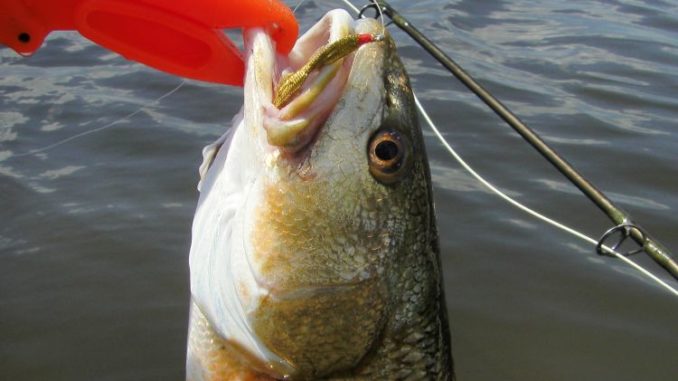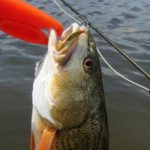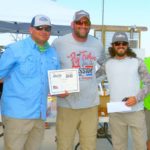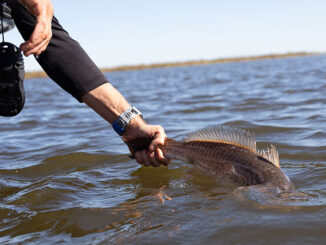
Tough day? send Spoon flies to the rescue
At the recent “Fly Fishin’ For the Mission” tournament held out of Pointe-aux-Chenes, my teammate Kevin “Doc” Andry and I started the day hoping to repeat as overall champions.
After four hours on the water, it was looking like we might win something — like one-way tickets to Skunk City. Maybe it was the full moon, or maybe it was the barometric pressure. But the fish wouldn’t even look at our flies, much less eat them.
Fortunately, we each had weapons of mass redfish destruction — spoon flies. Not wasting any more time, we put them to use. Long story short: We ended up landing 13 reds, releasing all but four, and finishing third overall, and highest among kayak teams.
Why spoon flies work
When it comes to catching slot and juvenile redfish, a spoon fly is money in the bank. It’s also caught more different species than any fly other than the Clouser Minnow.
Some say a spoon fly imitates a wounded or frightened baitfish. It could also be an attractor pattern — the marsh version of the coldwater trout angler’s Stimulator fly. It doesn’t imitate anything specific, but triggers the fish’s predatory instinct.
There are several reasons I love fishing spoon flies.
First, they’re lightweight and easy to cast. Second, they make almost no splash in the water, so they’re much less likely to spook fish. And if they’re of the Wobbler variety, they can be worked in very shallow water or heavy grass.
But perhaps the best reason is that, with their flash and vibration, they increase the radius of awareness to the fish. In clear water and good conditions, I’ve seen reds dart from 10 feet away to eat a spoon fly.
Matching the hatch
Jon Cave is credited with creation of the first spoon fly in the mid-80s. His Cave’s Wobbler was constructed of a body of flattened mylar tubing, and epoxied over. The tail had a tuft of kiptail and a few strands of krystal flash.
Soon after came variations that eliminated the tail. Kirk Dietrich, a Chalmette native, created a mylar tubing body with more of a spoon shape. Capt. Jim Dupre of Gainesville, Florida created his version using mylar foil cut to shape and epoxied to a hook.
The Kirk’s Spoon and Dupre Spoon Fly remain two of the most popular commercial redfish flies on the market.
Another variation is the Fingernail Spoon, popularized by Capt. Blaine Townsend of Cocodrie. This one uses a plastic fake fingernail epoxied to the hook, with glitter added to the epoxy that covers the fingernail and bonds to the hook.
And then there’s the Waldner Spoon, created by Capt. Rich Waldner of New Orleans. This fly uses the “Mother of Epoxy” technique where the fly body is shaped by four strands of wire, and then the spaces filled with epoxy supplemented with glitter of any color.
There are many other variations. One of my favorites is the Beer Can Spoon, where a cut-to-shape aluminum can piece is pressed into a concave mold, then epoxied onto the hook.
There’s no argument that spoon flies were inspired by the Johnson Sprite lure, which is why some purists refuse to fish it — regardless of how effective it is.
Wobblers vs. Spinners
All of the spoon flies mentioned so far are wobblers. That is, they have a concave shape that when retrieved through the water causes them to ride hook up with a wobbling motion of 15 to 30 degrees each side.
The concave shape of wobblers makes them perfect for shallow water. But drag-induced lift means they can’t be fished deep without lots of weight.
That’s where the Coma Spoon came in. I created this variation based on the physics of the Sauvage screw-type propeller.
The Coma Spoon is a spinner. Unlike the concave teardrop shape of wobblers, this fly is tied using narrow mylar tubing on a 4X long hook. After flattening and firming the body with 5-minute epoxy, I add a twist to the body before applying a finish coat of 30-minute epoxy.
What keeps a spinner from twisting line? First, a tippet material with high torsion resistance, such as fluorocarbon. Second, a retrieve with a short strip followed by a one-second pause. The fly rotates one direction on the strip, then reverses back on the pause.
In my saltwater fly box, I keep both wobblers and the Coma Spoon (spinner).
Bad day for redfish
The 2nd annual FFFTM tournament out of PAC Kayak Rentals was a great success, according to organizer Mathew Roberts. With a larger turnout and more sponsors, it helped raise money and awareness for the Mission Six charity, which benefits veterans. And with low wind and blue skies, it was a great day to be on the water.
Most of the state’s top saltwater fly anglers were on hand, and shared secrets with their counterparts. That was bad news for the reds. Despite their skittish attitude, nearly everyone caught fish. And some impressive two-fish stringers were weighed in, as well.
Fly Fishin For The Mission II Results:
Overall
1st – Shane Coleman, Mark Carline
2nd – Ron Begnaud, Barrett Bertucci
3rd – Kevin Andry, Glen Cormier
Kayak Division
1st – Jerry Bourgeois
2nd – Sarah Giles, Nick Dinger
3rd – Grant Hollier, Robert Oster
Boat Division
1st – Scott Bienvenu, Brock Miller
2nd – Phillip Schexnayder, Corey Legendre
3rd – Eric Ditch, Tim Gray
Sheepshead
Nick Dinger – 4.20 lbs
Largest Red
Mark Carline – 8.81 lbs




